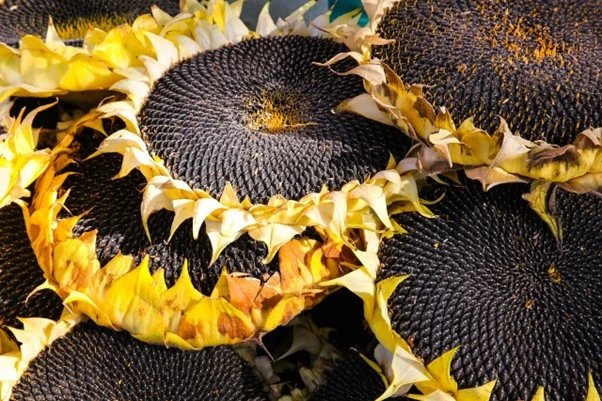Unlocking the Potential of the Sunflower Oil Industry
Sunflowers, with their bright yellow petals and towering stems, are not just a visual delight. They are also a powerhouse in the agricultural sector. For centuries, sunflowers have been cultivated for their seeds, which are a rich source of Sunflower oil.
As the global demand for vegetable oils continues to rise, the potential of sunflower harvesting for the oil industry is becoming increasingly evident. Let’s delve into the world of sunflower oil production and understand its significance.
A Brief History of Sunflower Oil Production
Sunflower oil has been used for cooking and medicinal purposes for thousands of years. Native to North America, sunflowers were cultivated by indigenous tribes who recognized the value of the seeds. The practice of extracting oil from sunflower seeds was later introduced to Europe in the 16th century, where it gained popularity as a cooking oil.
Why Sunflower Oil?
Sunflower oil is prized for its light taste, frying performance, and health benefits. It is rich in Vitamin E and low in saturated fat. Moreover, sunflower oil does not contain any allergens, making it a safe choice for those with food sensitivities. Its high smoke point makes it ideal for frying, and its mild flavor ensures that it doesn’t overpower the taste of dishes.
The Potential of Sunflower Harvesting
1. Sustainable Farming
Sunflowers: The Hardy Plants: Sunflowers are truly remarkable in their adaptability. Their ability to thrive in a variety of soil types—from sandy, loamy, to even clayey soils—makes them a versatile choice for farmers across different regions. This adaptability reduces the need for soil amendments and interventions, leading to lower input costs.
Water Efficiency: In an era where water scarcity is becoming a pressing global issue, the water efficiency of sunflowers stands out. Compared to crops like soybeans or canola, sunflowers require less water, making them particularly suitable for regions prone to drought or with limited water resources. This not only ensures a crop yield even in tougher conditions but also aids in sustainable water management.
2. High Oil Yield
The Oil-Rich Seeds: The fact that sunflower seeds can contain up to 50% oil is a testament to their efficiency as an oil source. When compared to other oilseed crops like soybeans, which have an oil content of about 20%, or peanuts, with around 50% but a lower yield per hectare, sunflowers clearly have an edge.
Maximizing Production: This high oil content means that farmers get a better return on their investment in terms of oil output. For industries, this translates to lower costs of production per liter of oil extracted, making sunflower oil a cost-effective choice.
3. By-products Utilization
Sunflower Meal – Beyond Waste: Once the oil is extracted from sunflower seeds, what remains is far from waste. The residual sunflower meal is packed with protein, making it an excellent choice for animal feed. Livestock, especially cattle, and poultry, benefit from this protein-rich feed, leading to better growth rates and overall hea
Eco-friendly Production: The ability to utilize almost every part of the harvested crop ensures a reduced carbon footprint. Instead of discarding by-products, they are channeled into another industry, ensuring a circular economy approach and minimizing environmental impact.
4. Economic Benefits
Growth in the Vegetable Oil Market: As global cuisines evolve and the demand for healthier cooking oil options rises, the vegetable oil market is witnessing steady growth. Sunflower oil, with its health benefits and culinary versatility, is poised to capture a significant market share.
Stability for Farmers: For farmers, this growing demand means more than just profits. It signifies market stability, ensuring that their crops will have consistent demand year after year. This stability allows for long-term planning, infrastructure investment, and the adoption of innovative farming techniques, all of which contribute to a more robust agricultural sector.
Challenges in Sunflower Harvesting
1. Pest and Disease Management
The Vulnerability of Sunflowers: Despite their hardy nature, sunflowers are not immune to the threats posed by pests and diseases. Common pests like the sunflower beetle, stem weevil, and moth larvae can wreak havoc on sunflower fields. Diseases such as downy mildew, rust, and verticillium wilt can significantly reduce yields and affect the quality of the harvested seeds.
The Need for Effective Strategies: Combatting these threats requires a multi-pronged approach. Integrated Pest Management (IPM) strategies, which combine biological, cultural, physical, and chemical methods, can be effective. For instance, crop rotation can disrupt the life cycle of pests, while the introduction of beneficial insects can naturally control pest populations. However, the challenge lies in implementing these strategies effectively and consistently, ensuring that they are environmentally sustainable and economically viable.
2. Harvesting Techniques
The Delicate Timing: Sunflowers have a relatively narrow window for optimal harvesting. Harvest them too early, and the moisture content can be too high, leading to problems during oil extraction. Harvest them too late, and the seeds may have lost some of their oil content or, worse might have been affected by early frost or other environmental factors.
The Role of Technology: Modern agriculture has the advantage of technology. Drones equipped with sensors can monitor crop maturity and moisture levels, helping farmers decide the best time to harvest. Precision harvesters can then be used to pick the sunflowers at their peak, ensuring maximum oil yield and quality.
However, the challenge is making these technologies accessible and affordable for all farmers, especially those in developing regions.
3. Market Fluctuations
The Volatile Nature of Commodity Prices: The price of sunflower oil, like many agricultural commodities, is subject to fluctuations based on various factors. These can range from global production levels, geopolitical events, trade policies, and even weather patterns in key producing regions.
Equipping Farmers with the Right Tools: To navigate this volatility, farmers need more than just good harvests; they need good market intelligence and risk management strategies. Forward contracts, futures, and other financial instruments can help farmers lock in prices and hedge against potential losses.
Additionally, diversifying crops or exploring value-added products from sunflowers can provide an additional buffer against market downturns. The challenge is in educating farmers about these tools and making them readily available.
The Future of Sunflower Harvesting for the Oil Industry
- Technological Advancements: With the advent of precision agriculture, such as GPS and autopilots for tractors, farmers can now use drones, sensors, and data analytics to monitor the health of their crops, optimize irrigation, and determine the best time to harvest.
- Breeding Innovations: Research is underway to develop sunflower varieties that are more resistant to pests, diseases, and extreme weather conditions. These varieties can potentially increase yields and reduce production costs.
- Sustainable Practices: As the world moves towards sustainable agriculture, practices like crop rotation, organic farming, and water conservation will play a pivotal role in sunflower cultivation.
- Value-added Products: Beyond cooking oil, there’s potential to explore other products derived from sunflower oil, such as biofuels, cosmetics, and health supplements.
Wrapping Up
Sunflower harvesting holds immense potential for the oil industry. As the world grapples with the challenges of climate change, food security, and sustainable agriculture, sunflowers emerge as a beacon of hope.
They offer a blend of economic viability and environmental sustainability. By investing in research, technology, and sustainable farming practices, we can unlock the full potential of sunflower harvesting and pave the way for a brighter, greener future.
Authors bio
Lucas Green is a young digital marketing enthusiast from Phoenix, Arizona, US. Passionate about graphic design, social networking, content writing, and business in general. In his spare time, he writes extensively about graphic design, traveling, and business for Blog Post Biz.


